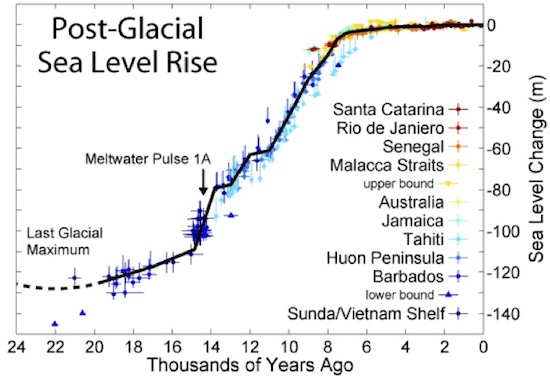"The rain in Spain .... stays mainly in the plain" sings Eliza Doolittle in the theme song of My Fair Lady, - but not just in Spain, also in Australia.
A new study to be published in the journal
Geophysical Research Letters says the massive rainfalls in Australia in 2011 and 2012 caused a global sea level decrease of 7 mm (about 1/3 inch).
Ocean Water Levels
The water level in the world's oceans had been rising steadily over quite some time. Ever since the last ice age's great ice masses in the northern hemisphere started to melt in earnest, some 15,000 years ago, all that melt-water flowed into the oceans and resulted in a rapid rise of 100+ m. Beginning some 7,000 years ago, most of the ice had melted and the ocean level rise slowed to a trickle. Over the last 200 years it rose less than 30 cm. Claims of a renewed acceleration of sea level rise have largely
been shown to be false.
Apart from lack of (additional) melt water, water was then being retained on the continents in form of lakes, rivers and continental aquifers, as well as in the atmosphere. A new (near) equilibrium had been reached, as evident from the graph following (source: Wikipedia).

While the postglacial sea level rise not only has significantly slowed compared to the 10,000-year period immediately preceding it, some areas are actually experiencing the opposite, namely a decline of sea levels due to isostatic rebound.
Isostatic Rebound
Isostatic Rebound is the term used for the postglacial rise of the land mass in the northern hemisphere after the weight of the continental ice sheets had disappeared. That process is still ongoing and its evidence can be seen along the coastline of Norway, where undisturbed coarse gravel shore deposits rise in numerous steps to heights of 20 m above the ocean level. Parts of northern Europe and North America are still rebounding, though not all evenly. In some areas the rate of rebound is in excess of 10 mm per year (!).
Oceanic Atolls
But, some say, the oceanic atolls are drowning in the rising sea and the people inhabiting atolls in the Pacific Micronesia archipelago, in the Maldives in the Indian Ocean and on other atolls are all fleeing for their lives. Not so, not so at all. All these nations have expanding in populations and many are actually increasing in size. That's due to the steady build-up of new coral in the surrounding reefs and the storms pushing the broken coral up on land.
Nature's Capers
Nature can be capricious and moody. From droughts to floods, from heat to cold, she has a large repertoire and likes to serve surprises, creating havoc here and there. The colossal rains in Australia were one of those moody surprises. While certainly quite damaging for many residents, for the continent as a whole, the rains helped greatly to
replenish the aquifer in the Great Artesian Basin of Queensland with fresh water. Just as Eliza sang, "the rain stays mainly in the plain."
 While the postglacial sea level rise not only has significantly slowed compared to the 10,000-year period immediately preceding it, some areas are actually experiencing the opposite, namely a decline of sea levels due to isostatic rebound.
While the postglacial sea level rise not only has significantly slowed compared to the 10,000-year period immediately preceding it, some areas are actually experiencing the opposite, namely a decline of sea levels due to isostatic rebound.